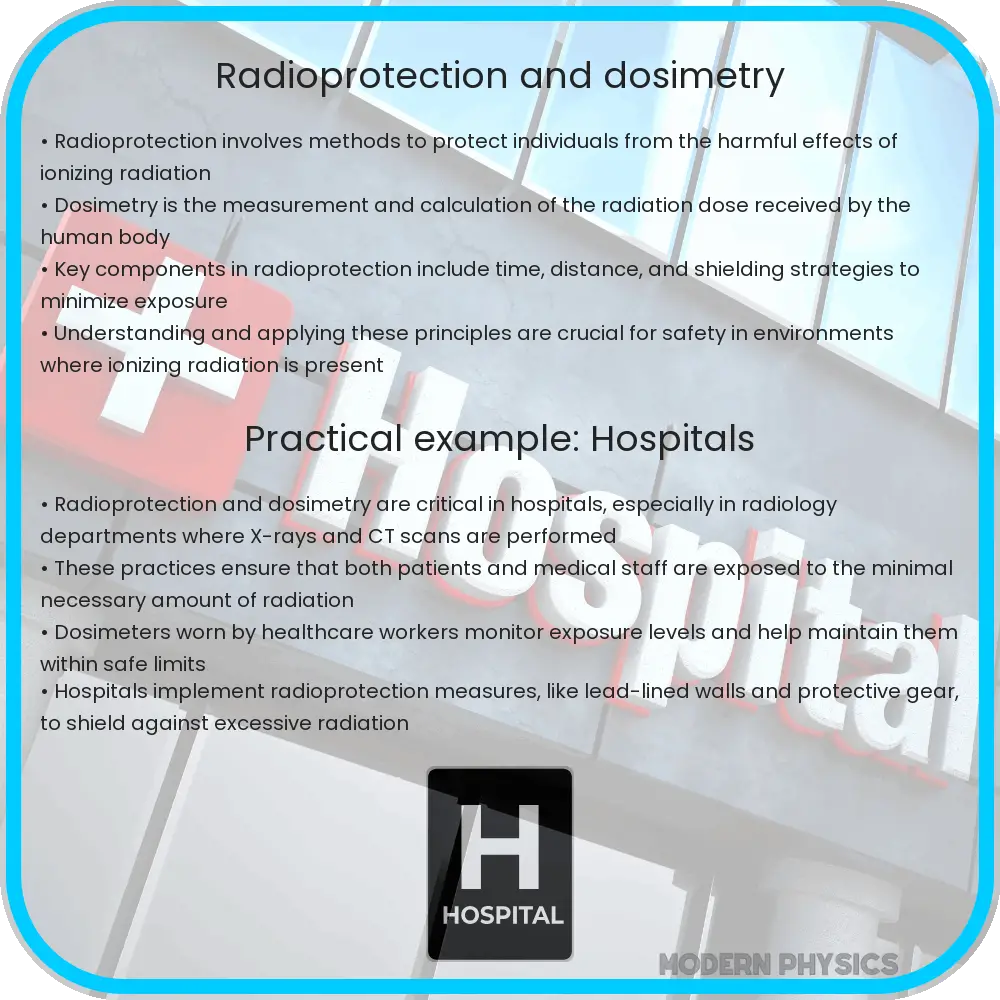Learn about radioprotection and dosimetry, essential in protecting against harmful effects of ionizing radiation and measuring radiation dose.

Introduction to Radioprotection and Dosimetry
Radioprotection and dosimetry are critical concepts in the field of radiation physics, playing essential roles in both medical and industrial applications. Radioprotection, also known as radiation protection, involves the protection of people from harmful effects of exposure to ionizing radiation, which can include x-rays, gamma rays, and particle radiation. Dosimetry is the science of measuring and assessing the radiation dose absorbed by the human body. The interplay between these two domains ensures safety in environments where radiation is used.
Understanding Radiation and Its Risks
Ionizing radiation possesses enough energy to ionize atoms or molecules by detaching electrons from them, leading to chemical and biological changes. It’s critical to manage and minimize exposure to this type of radiation due to its potential to cause health issues like cell damage, radiation sickness, and increased cancer risk. The principle sources of ionizing radiation can be natural, like radon in the air, or man-made, such as medical x-rays or industrial radiography equipment.
Principles of Radioprotection
To safeguard health, radioprotection employs three fundamental principles:
- Justification: Ensuring any decision that exposes people to radiation is justified by weighing the expected benefits against the potential risks.
- Optimization: Implementing all possible protective measures to keep exposures as low as reasonably achievable, often abbreviated as ALARA.
- Limitation: Applying strict dose limits to prevent excessive exposure to individuals.
Basics of Dosimetry
The science of dosimetry involves the calculation and assessment of the radiation dose received by the human body. This science plays a crucial role in radioprotection by quantifying exposure levels and helping enforce safety standards and regulations. Dosimeters, which measure dose uptake, are used extensively in fields like healthcare, nuclear power, and research.
Dosimetry can be categorized into two types:
- Passive Dosimetry: Utilizes devices like thermoluminescent dosimeters (TLDs) and film badges to record exposure that is later read in a laboratory.
- Active Dosimetry: Involves the use of electronic devices that provide real-time dose readings, which is especially valuable in high-risk or variable exposure environments.
Applications of Radioprotection and Dosimetry
Both radioprotection and dosimetry find meaningful applications across a range of fields:
- Medical Field: Protecting patients and staff from unnecessary exposure during diagnostic radiography and radiotherapy treatments.
- Nuclear Industry: Monitoring radiation levels to protect workers and the environment in power generation facilities.
- Research: Ensuring safe handling of radioactive materials in scientific studies.
Regulatory Framework and Standards
In ensuring the efficacy of radioprotection and dosimetry practices, adherence to international and national standards is paramount. Regulatory bodies like the International Atomic Energy Agency (IAEA) and national regulatory authorities establish guidelines and standards that dictate safe levels of radiation exposure and operational procedures. These regulations are based on ongoing research and epidemiological studies that help refine safety measures and response strategies in the face of radiological incidents.
Educating and Training in Radioprotection
Effective radioprotection also hinges on the education and training of professionals who work with or around radiation. Specialized training programs are designed to educate employees about the risks associated with radiation, safe handling practices, and emergency procedures. This knowledge is crucial not only for safety but also for fostering a culture of security and compliance within organizations handling radioactive materials.
Technological Advancements in Dosimetry
Advancements in technology continually enhance the accuracy and efficiency of dosimetry equipment. Modern dosimeters are more sensitive, provide quicker readings, and are capable of distinguishing between different types of radiation. Information technology integration allows for better data tracking and real-time monitoring, facilitating quick adjustments in operational settings to maintain safe exposure levels.
Challenges and Future Directions
The dynamic nature of radiological science presents both challenges and opportunities for further improvement in radioprotection and dosimetry. Researchers are actively working on developing new materials and technologies that reduce radiation exposure even further. Moreover, the global nature of radiation safety demands international cooperation in sharing best practices, data, and innovations. The future of radioprotection and dosimetry is likely to see enhanced integration with digital technologies, leading to smarter, more responsive systems.
Conclusion
Radioprotection and dosimetry are crucial in maintaining safety where ionizing radiation is present. By understanding and managing risks, adhering to strict principles, and applying comprehensive dosimetry, we safeguard health and ensure the responsible use of radiation in various industries. The ongoing advancements in technology and methodology will continue to enhance these fields, aiming towards even greater efficiency and safety. As we continue to explore the potentials of radiation, whether in medicine, industry, or research, the principles of radioprotection and dosimetry will remain foundational to achieving a balance between beneficial uses and safety precautions.
